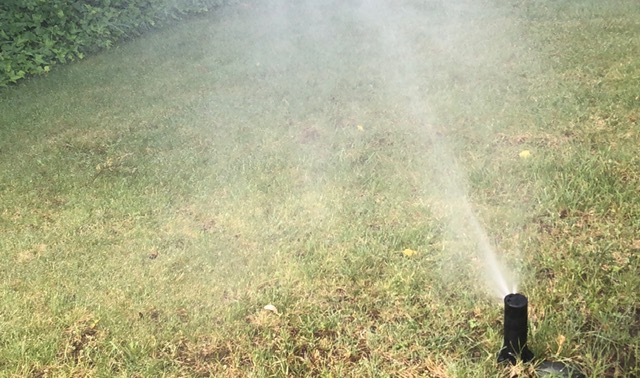
Sacramento region cut overall use by 17% in October

|
| Sprinklers and other irrigation systems were turned off in October and water use dropped after the atmospheric river dumped nearly 7 inches of rain on Sacramento. (Photo: Kathy Morrison) |
What a difference a downpour makes! October’s historic “atmospheric river” made a big impact on local water use.
According to the Regional Water Authority, Sacramento-area residents reduced their water use by 17% in October compared to October 2020. Some cities, such as Roseville, reduced water use by more than 20%. October’s statistics were released Wednesday.
That same month, Sacramento received a record 6.71 inches of rain, more than three times normal for October.
“The significant decrease in October demonstrates just how much weather and landscape water use impact the region’s overall water-use patterns as people turned off their sprinkler systems with the rain,” said Amy Talbot, RWA water efficiency program manager. “
"Some of this savings will become permanent as water providers, such as the City of Sacramento, continue to experience a surge in rebate applications for replacing lawn with low-water landscaping.”
Since the last major drought, Sacramento-area residents already had reduced their water consumption by 13%. These new reductions are on top of those savings.
RWA is the umbrella organization representing 20 local water providers serving about 2 million people in the greater Sacramento area.
Before October’s rain, regional water providers did more than urge conservation while coping with severe drought and the longest dry spell in Sacramento history. According to the RWA’s estimates, water providers used 34% more groundwater compared to previous years.
“Conservation is critical but not the only drought response underway,” said RWA Executive Director Jim Peifer. “Operational adjustments, such as using more groundwater, also reduce the region’s reliance on Folsom Lake and the Lower American River for drinking water, leave more water for the environment, but are far less dependent on external factors such as weather.”
Despite that soggy October, we’re not out of the drought yet. Customers are asked to continue conserving water during the fall and winter months – and work on saving year-round. Rebates are available now for retrofitting irrigation, converting turf to water-wise landscaping, upgrading appliances and more.
“We know that customers are responding to drought, but we need to work together to do more,” Talbot said. “Keep up the good work by reducing landscape watering significantly and turning sprinklers off during rain, while continuing to water trees.”
Water-wise tips, rebate information and watering guidelines for each water provider are available at BeWaterSmart.info .
Comments
0 comments have been posted.Sacramento Digs Gardening to your inbox.
Food in My Back Yard Series
May 6: Maintain soil moisture with mulch for garden success
April 29: What's (already) wrong with my tomato plants?
April 22: Should you stock up on fertilizer? (Yes!)
April 15: Grow culinary herbs in containers
April 8: When to plant summer vegetables
April 1: Don't be fooled by these garden myths
March 25: Fertilizer tips: How to 'feed' your vegetables for healthy growth
March 18: Time to give vegetable seedlings some more space
March 11: Ways to win the fight against weeds
March 4: Potatoes from the garden
Feb. 25: Plant a fruit tree now -- for later
Feb. 18: How to squeeze more food into less space
Feb. 11: When to plant? Consider staggering your transplants
Feb. 4: Starting in seed starting
Sites We Like
Garden Checklist for week of May 11
Make the most of the lower temperatures early in the week. We’ll be back in the 80s by Thursday.
* Plant, plant, plant! It’s prime planting season in the Sacramento area. Time to set out those tomato transplants along with peppers and eggplants. Pinch off any flowers on new transplants to make them concentrate on establishing roots instead of setting premature fruit.
* Direct-seed melons, cucumbers, summer squash, corn, radishes, pumpkins and annual herbs such as basil.
* Harvest cabbage, lettuce, peas and green onions.
* In the flower garden, direct-seed sunflowers, cosmos, salvia, zinnias, marigolds, celosia and asters. (You also can transplant seedlings for many of the same flowers.)
* Plant dahlia tubers.
* Transplant petunias, marigolds and perennial flowers such as astilbe, columbine, coneflowers, coreopsis, dahlias, rudbeckia and verbena.
* Keep an eye out for slugs, snails, earwigs and aphids that want to dine on tender new growth.
* Feed summer bloomers with a balanced fertilizer.
* For continued bloom, cut off spent flowers on roses as well as other flowering plants.
* Add mulch to the garden to maintain moisture. Mulch also cuts down on weeds. But don’t let it mound around the stems or trunks of trees or shrubs. Leave about a 6-inch-to-1-foot circle to avoid crown rot or other problems.
* Remember to weed! Pull those nasties before they set seed.
* Water early in the day and keep seedlings evenly moist.